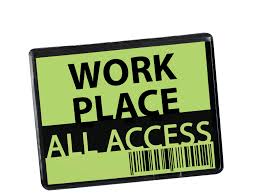Embracing a Culture of Accessibility in the Workplace
October 26, 2015

|
As a full-time wheelchair user, there are unfortunately few accessibility issues I encounter that surprise me. Yet, when I accepted a position about two years ago at an office specifically dedicated to working for the disability community, it never crossed my mind that the building would be difficult for me to navigate. Sadly, despite being a veteran of access failures, the inaccessibility I encountered while working there was completely shocking. The parking lot had no spaces accessible to my adapted van, building exits led to high curbs, I could barely fit in any of the restrooms, and the only emergency exit led to a staircase. It was appalling, but it was also a powerful reminder of just how far the United States has left to go to make workplaces accessible to everyone.
Ensuring equal access isn't just the right thing to do; it's the law. First and foremost, the physical environment of buildings must be accessible to people with disabilities in accordance with legal requirements. The Americans with Disabilities Act (ADA) sets forth several building standards that should be commonplace, but are still not adhered to in many workplaces. When a workplace has access barriers (especially ones that could easily be remedied) it sends a message that disabled people are neither wanted nor welcome in the workforce. This is how I felt in the inaccessible building at my old job - out of place and burdensome for even requesting access changes.
There's much more to workplace accessibility, though, than installing a ramp or adding handrails to a restroom stall. All too often, employers misunderstand disability, assuming that if they've provided the bare minimum of access for one person, they've provided access for all. This is where reasonable accommodations come into play. It's crucial to remember that all employees are individuals with unique needs and abilities. For example, some people with visual disabilities may need screen readers to complete work, and some may need dictation software. Unless, an accommodation will cause undue hardship for a place of employment, it's required for employers to make necessary adaptations to ensure equal access.
Equally as important as reasonable accommodations is using accessible technology throughout a workplace. Sections 503 and 508 of the Rehabilitation Act govern technology access. Following the standards outlined in these sections has benefits far beyond simply complying with the law. Technology adaptations for those with disabilities often means software and hardware is easier to navigate for all employees making everyone more productive. The adaptations ensure equality and inclusion for everyone. It's win-win.
If a place of work has an environment accessible to people with mobility disabilities, provides assistive technology for those who request such accommodations, and uses accessible technology they should be commended for adhering to the law. That being said, true access goes far beyond legal compliance, and this is where workplace culture needs the most improvement. Each time I was in the inaccessible building at work, I felt as though I wasn't valued as a contributing worker. This needs to change.
Employers who take the time to think outside the box and work with employees to problem solve accessibility issues are the ones likely to have the most hardworking and dedicated employees. Moreover, genuine regard for a diverse range of access needs is a direct path to fostering acceptance and open lines of communication among colleagues. Although over 25 years of the ADA have yet to make accessibility a given in the workplace, it is time for all employers to show willingness and commitment to make full accessibility a reality.
***
 Emily Ladau is a writer and disability rights activist whose passion is to harness the powers of language and social media as tools for people to become informed and engaged social justice advocates. She is the owner of Social Justice Media Services, which provides communications, outreach, and social media management services for disability-related organizations. Emily also maintains a blog, Words I Wheel By, as a platform to address discrimination and to encourage people to understand the experience of having a disability in more positive, accepting, and supportive ways. You're welcome to connect with her on Facebook and Twitter.
Emily Ladau is a writer and disability rights activist whose passion is to harness the powers of language and social media as tools for people to become informed and engaged social justice advocates. She is the owner of Social Justice Media Services, which provides communications, outreach, and social media management services for disability-related organizations. Emily also maintains a blog, Words I Wheel By, as a platform to address discrimination and to encourage people to understand the experience of having a disability in more positive, accepting, and supportive ways. You're welcome to connect with her on Facebook and Twitter.







